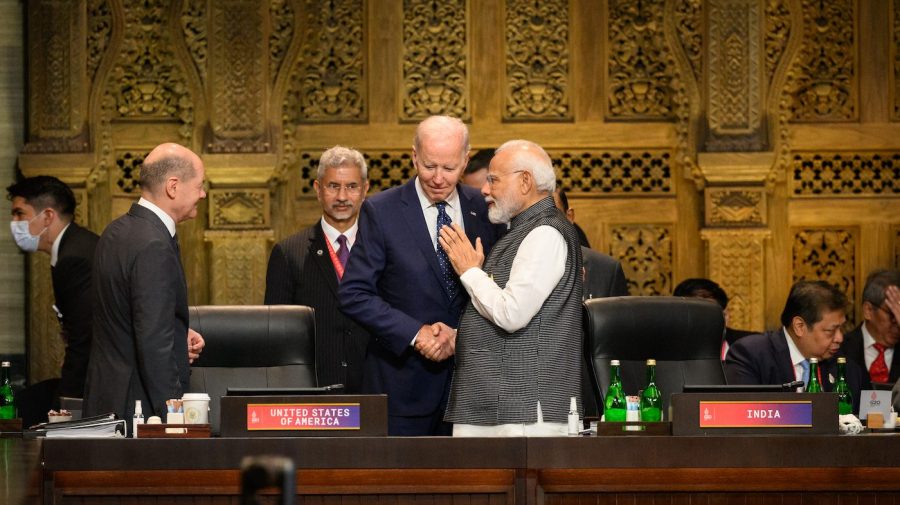Modi in Washington: A symbolic visit for a substantive partnership

NUSA DUA, INDONESIA – NOVEMBER 15: Chancellor Olaf Scholz of Germany (2L), President Joe Biden of the United States of America (C) and Prime Minister Narendra Modi of India (R) chat ahead of a working session on food and energy security during the G20 Summit on November 15, 2022 in Nusa Dua, Indonesia. (Photo by Leon Neal/Getty Images,)
Officials from the United States and India occasionally have some difficult private conversations about Ukraine and India’s domestic politics. But the official state visit this week by Indian Prime Minister Narendra Modi to the U.S. will mainly be about showcasing the strength of the two countries’ burgeoning partnership.
Modi and President Joe Biden both need the optics of a visit rich in symbolism to demonstrate the substantive achievements of a relationship based on shared concerns about China and multi-billion dollar deals in technology and defense. Modi wants to highlight his standing as a world leader ahead of the 2024 Indian election. Biden wants to underline that, contrary to the criticism of some, he does have a plan to deal with China’s rise and the U.S. has lined up partners and allies to execute that plan.
Indian prime ministers have been regular visitors to Washington D.C. since India’s independence in 1947. But Modi’s visit is only the third time an Indian prime minister will be given official state visit protocol, including a state banquet at the White House on June 22.
The fifth Indian prime minister to address a joint session of Congress, Modi will be the only Indian leader to do so for a second time. Indians will be thrilled by the attention given to their prime minister, and the speeches about shared values and similar strategic vision of the world’s oldest and largest democracies will play well in the Indian media.
But the visit will not be about just pomp and show. Trade in goods and services between India and the U.S. reached $190 billion last year and the U.S. is now India’s largest trading partner. Companies from the two countries have made significant investments across borders and Indian and American enjoy close people-to-people ties.
Moreover, the U.S. is keen to “friendshore” with India to deal with the threat America sees in China’s rise, and to ensure supply-chain resilience. This involves shifting the manufacturing of certain critical components from China to friendly countries, especially India. The U.S. is funding Indian technology startups and infrastructure projects from its $200 billion Partnership for Global Infrastructure and Investment (PGII) Fund.
India, as the world’s most populous country, represents a large potential market for U.S. companies currently reducing their Chinese presence. When Air India, India’s largest airline, decided to purchase 220 Boeing aircraft in a $34 billion deal, Biden celebrated, saying it “will support over 1 million American jobs across 44 states, and many will not require a four-year college degree.” U.S. aerospace and military industries have wanted a greater share of the Indian market for years.
This January, India and the U.S. announced the launch of the U.S.-India Initiative on Critical and Emerging Technologies (iCET) to the pave the way for “technology value-chain partnerships that would lead to co-development and co-production of high technology products and services in both countries,” in the words of National Security Adviser Jake Sullivan.
During a recent visit to Delhi by Secretary of Defense Lloyd Austin, a defense industrial roadmap was unveiled, reflecting an American willingness to share state-of-the-art technology with India. But India wants to build an indigenous defense industry and is keen on American technology and investment, while the U.S. wants India to stop purchasing military equipment from Russia and buy more from the United States. Historically, that divergence has resulted in announcements that have not always resulted in implementation.
For the Modi visit, the two sides have planned two key defense related deliverables: the purchase by India of 30 General Atomics-manufactured Predator or MQ9B Sea Guardian drones for $3 billion, and an agreement between General Electric and Hindustan Aeronautics Limited to coproduce GE-F414 turbofan engines for India’s indigenous Tejas Mark-2 fighter jet.
India and the U.S. have a long way to go before reaching the $500 billion mark in bilateral trade, which experts see as the future potential of the trade relationship. Americans blame India’s default preference for protectionism, reluctance to offer a level playing field to domestic and foreign players, strict digital privacy rules, and historical skepticism towards free and open trade. Indians complain that America is used to allies who are junior partners, not a country that is not an ally and wants to be treated as an equal. India is not alone in that view in an era when several powers want recognition and are showing a preference for economic and technology partnerships, rather than military alliances.
India is not a treaty ally of the United States, but a partner that prides itself on its strategic autonomy and one that has reservations about how it was treated by U.S. officials in the past. The closest equivalent of that in U.S. experience from the Cold War era would be France under the Gaullists. But just as the U.S. overcame its reservations about real or perceived French prickliness in the interest of preserving the Atlantic Alliance, Americans realize the importance of India in their plans for maintaining a rules-based international order.
Husain Haqqani, Pakistan‘s former ambassador to the U.S., is Diplomat-in-Residence at the Anwar Gargash Diplomatic Academy in Abu Dhabi and Senior Fellow at the Hudson Institute. Aparna Pande is Director of the Initiative on the Future of India and South Asia at the Hudson Institute.
Copyright 2023 Nexstar Media Inc. All rights reserved. This material may not be published, broadcast, rewritten, or redistributed.
